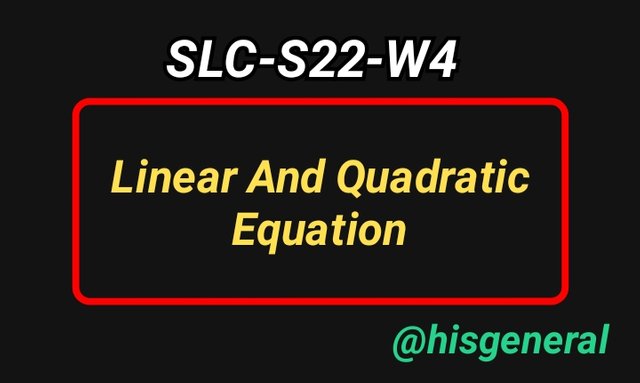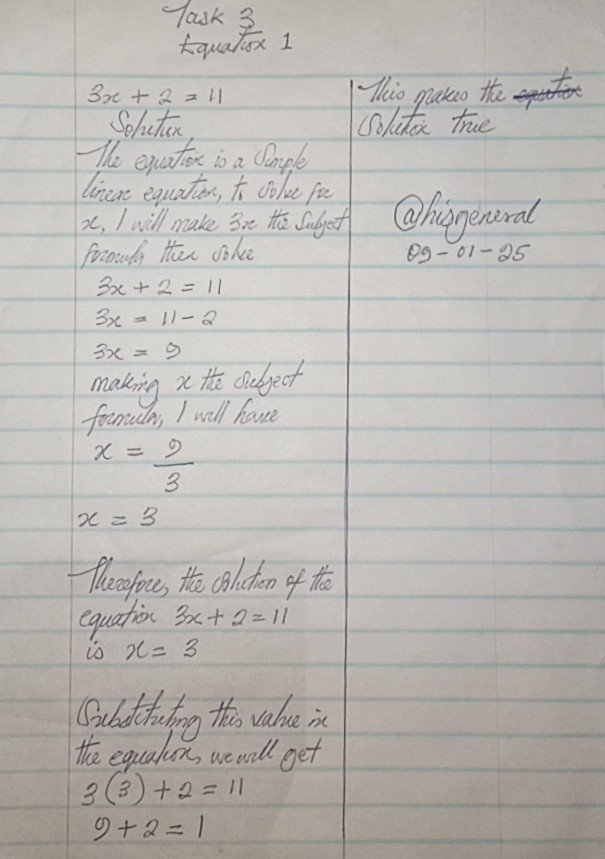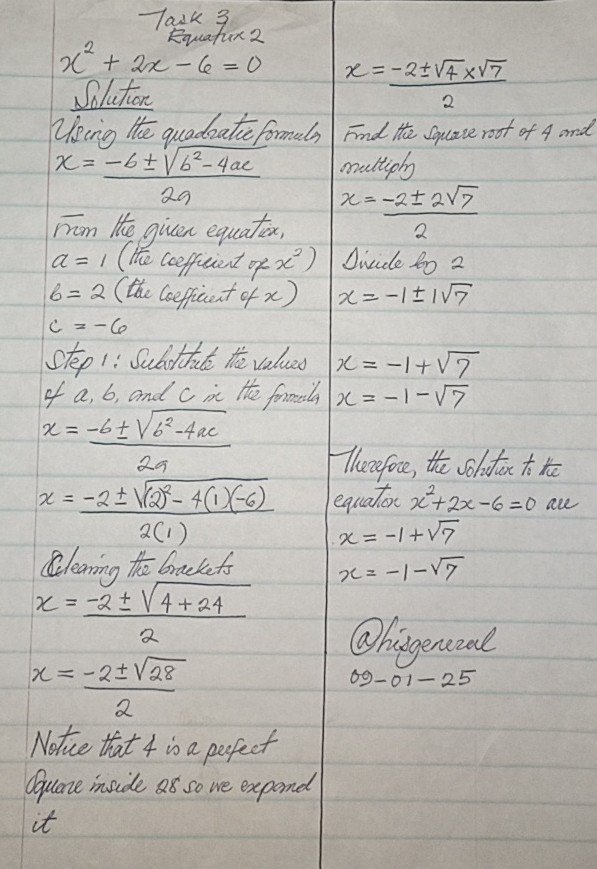
Hi friends, it is another time to do mathematics stuff, so you are once again welcome. We are looking at Linear and Quadratic Equations so let's get started...
Linear Equations
Linear equations, as explained in one of the previous classes, an equation that has 1 as the highest power of the variable. That is to say that in this equation, variable(s) are seen to be in a linear form, that is, not raised to any power, be it 2 or any other. The general form of a linear equation is
ax - by = c
where a and b are integers and coefficients, while x and y are variables, and c is a constant.
Examples of linear equations
• 2x - 3y = 9
• x + 6y = 4
• 5x = 10
These are algebraic examples of linear equations.
Practical examples
In a particular outlet, apples are sold at ₦2.75 per pound, and bananas are sold at ₦1.50. Supposing Mike bought x pounds of apple and y pounds of banana, the total cost (c) can be expressed in the linear equation:
c = 2.75x + 1.50y
Solving linear equations may involve collecting like terms, addition, subtraction, multiplication as well as division. Linear equations apply to real-world applications like engineering, computer science, physics, and economics.
Quadratic Equation
A quadratic equation on its own is said to be a degree two polynomial equation, meaning that it is an equation whose highest power of the variable (often x) is 2, generally taking the form:
ax² - bc + c = 0
Where a, b, and c are all integers and constants, x is the variable, and a cannot be zero; otherwise, it becomes a linear equation.
Examples of quadratic equations
• x² - 12x + 3 = 0
• 2x² + 5x + 3 = 0
• x² - 3 = 0
All of these are algebraic examples of quadratic equations.
Practical examples of quadratic equations
A company manufactures drinks, and the cost (c) of manufacturing x drinks is given by the equation:
c = 2x² + 5x + 200
The equation expresses the cost of production, in which 2x² is the materials cost, 5x is the labor cost, and 200 (the constant term) is the fixed cost.
Quadratic equations can be solved by formular method, factorization method, graphical method, or completing square method. They can also be applied to real-world applications like engineering, computer science, physics, and economics.
Difference between linear and quadratic equations
| Solution method | Solved by primary algebraic operations like subtraction, division, addition, and multiplication | Solved by methods like the quadratic formula, completing the square, factoring, and graphing |
| Graphical representation | Straight line graph | Parabola |
| Degree of variable | Has 1 as the highest variable (often x) power | Has 2 as the highest variable (often x) power |
| Number of solutions | Has only one solution | Can have two separate solutions, a repeated solution, or no real solutions |
| General form | ax + by = c; in which a, b, and c are constants and x the variable | ax² - bx - c = 0; in which a, b, and c are constants and x the variable |
Task 2
Describe methods for solving quadratic equations and share pros and cons for each method.
Factoring Method
Description: This method has to do with expressing the quadratic equation to be in the form (ax + b)(cx + d) = 0 thereafter solve for x
Advantages: It is simple to apply, gives true solutions, and is also an optimal method for simple quadratic equations.
Disadvantages: It may not be used for complex equations; hence, it is limited to factorable equations.
Quadratic Formula Method
Description: This method has to do with employing the form x = [-b ± √(b² - 4ac)]/2a in solving a quadratic equation
Advantage: It can be employed in solving various kinds of quadratic equations, provides true solutions, and is regarded as the great formula
Completing the Square Method
Description: This method has to do with arranging the quadratic equation to present it in the form (x + b)² = c and solve for x
Advantages: It offers true solutions, can be employed in solving every kind of quadratic equation, and is a nice method to use when solving equations that have complex coefficients
Disadvantage: Can involve difficult calculations, calls for cautious manipulation of the given equation
Graphical Method
Description: This method has to do with plotting the graph of the equation and locating the intersection points with the x-axis
Advantages: Allows solutions to be visually presented, can be employed in solving quadratic equations that have complex coefficients
Disadvantages: May not give true solutions, have limited correctness
3x + 2 = 11

x² + 2x - 6 = 0

The equation x + 3 = 15 is a simple linear equation so to solve for x, I will just make x the subject formula and then solve.
So from
x + 3 = 15
x = 15 - 3
x = 12
Therefore the solution to the equation x + 3 = 15 is x = 12
Substituting 12 for x in equation; 12 + 3 = 15 makes the solution true.
In terms of t, the equation h(t) = -5t² + 20t is a quadratic equation hence, we will need to simplify it to solve for h
h = -5t² + 20t
The equation is simplified in this form. Nevertheless, we will have to factor out a common term:
h = 5t(-t + 4)
This equation demonstrates a parabola opening downward. The highest value of h happens when -t + 4 = 0, which gives us:
t = 4
Substituting 4 for t in the original equation, we'll have:
h = -5(4)² + 20(4)
h = -5(16) + 80
h = -80 + 80
h = 0
Nevertheless, this isn't the highest value of h. To get the highest value, we have to get the vertex of the parabola.
Meanwhile, the vertex's x-coordinate is given by:
t = -b/2a
t = -20/2(-5)
t = -20/-10
t = 2
Substituting 2 for t in the original equation, we'll get:
h = -5(2)² + 20(2)
h = -5(4) + 40
h = -20 + 40
h = 20
Hence, the highest value of h is 20, which takes place when t = 2.
Thank you
Inviting @okere-blessing, @ruthjoe, and @ninapenda
Cc:
@khursheedanwar